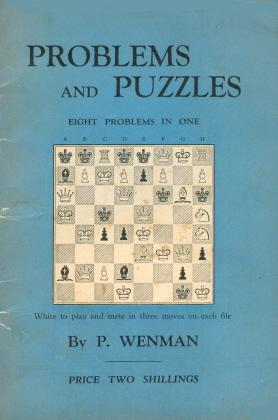
Edward Winter
The final paragraph of our Historical Havoc article referred, by no means appreciatively, to (Francis) Percival Wenman (1891-1972), and the present item focuses on his chess problem books. Page 310 of the 1992 edition of the Oxford Companion to Chess described him as ‘the problem world’s most notorious plagiarist’ and added regarding his 1943 work Problems & Puzzles: ‘Of the 70 problems in this book at least 40 owe their origin to other composers.’ Page 192 of The Even More Complete Chess Addict by M. Fox and R. James (London, 1993) stated that Wenman’s One Hundred Published Chess Problems ‘was notable for containing a quantity of problems by just about anybody but Percy Wenman’.

We have been re-examining all of Wenman’s problem books, wondering whether a devil’s advocate could construct any kind of defence for him.
With some of Wenman’s output, no issue of plagiarism arises. For instance, in 1946 he brought out two small (approximately 9 x 11.5 cm) booklets on problems by Guidelli and Ehrenstein in which he named himself merely as the compiler. The same year, he published Thirty Two-Movers in a similar format. Each problem was attributed to a composer, and two of them to Wenman. That was also the case with Thirty Three-Movers, issued in 1945.
For the charge of serial plagiarism, that leaves the following, larger, problem books (many of which were reissued/reprinted surprisingly often in the 1940s):
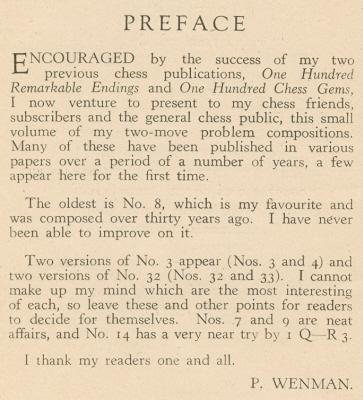
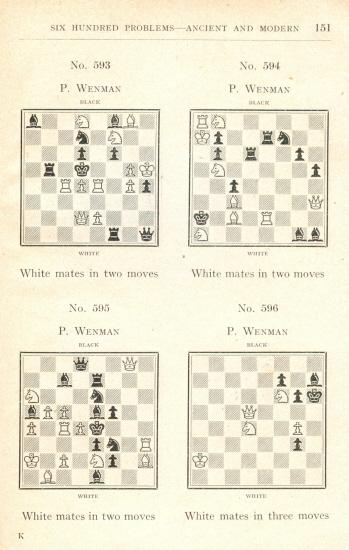
The devil’s advocate might therefore clutch hopefully at the absence of a direct claim to problem authorship by Wenman in the two books singled out by the Oxford Companion and the Addict book, i.e. Problems & Puzzles and One Hundred Published Problems. Only 50 Two-Move Problems contained an explicit statement by Wenman that he had composed the entire contents. However, it was established in the 1940s that Wenman not only lifted other composers’ work (50 Two-Move Problems was just one of the books found guilty) but also sometimes tampered with it (e.g. through rotation of the board), and that such perceived attempts to disguise the original authorship often impaired the composition. All this was demonstrated in an irrefragable exposé by ‘C.S.K.’ (Kipping) on pages 74-78 of CHESS, December 1946. An extract from page 75 illustrates the level of Kipping’s research and of Wenman’s piracy:
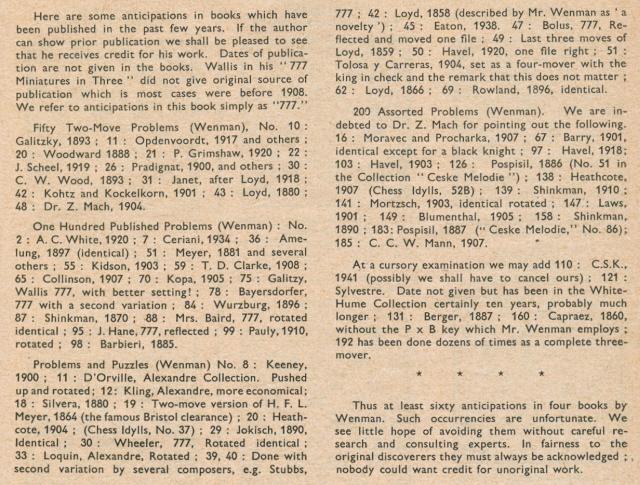
And so the devil’s advocate peters out. We have seen no response by Wenman to Kipping’s indictment, although one comment by Wenman on the subject of originality in composition comes to mind. It appeared on page 8 of the Falkirk Herald of 24 September 1941 and was reprinted on page 21 of the January 1942 BCM:
‘I do not think very much of some of the critics who always say: “it must have been anticipated” – or something to that effect. Actually there are no entirely original problems today by anyone, and there never will be, because all chess ideas are exhausted long ago. Positions are only recast; and if one has never seen a position before it is quite original so far as the new composer is concerned.’
Did Wenman genuinely believe that his large-scale ‘recasting’ was legitimate and ethical?
His anthologies on chess play were also deplorable, although not on grounds of plagiarism. The fact that One Hundred Remarkable Endings was described as ‘an excellent piece of work’ on page 227 of the 14 February 1939 CHESS simply shows that any chess book will be praised somewhere by someone. The fact that in 1995 Cadogan Books reissued Wenman’s One Hundred Chess Gems simply shows that any chess book may find itself reprinted by an undiscriminating or vulturine publisher.
About Wenman himself little information is currently to hand, beyond the basic record of his tournament and match play. Page 708 of the August 1912 issue of the Chess Amateur reported:
‘Wenman. This talented young expert, who has done so much for chess in Glasgow and the West of Scotland, is leaving for Canada. Some of his chess friends are promoting a testimonial to him’.
Whether he ever crossed the Atlantic we are not sure. Certainly he was in Scotland in the first months of the following year (BCM, April 1913, page 148), and the magazine carried a number of reports on his chess activities in Scotland during that decade.
Finally, a rare photograph of Wenman (in a group shot taken at Edinburgh, 1920, a few months after he became Scottish Champion) was published on page 277 of the September 1920 BCM:
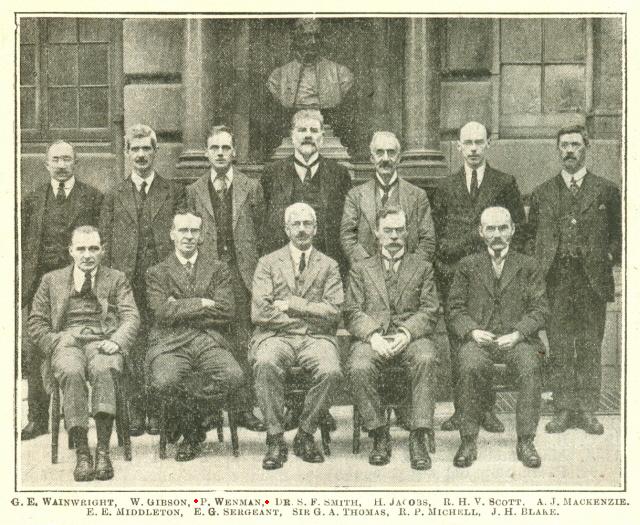
(5641)
Information is sought about this well-known Rice Gambit game, purportedly won in New York in 1900 by Professor Rice, against an unidentified opponent:
1 e4 e5 2 f4 exf4 3 Nf3 g5 4 h4 g4 5 Ne5 Nf6 6 Bc4 d5 7 exd5 Bd6 8 O-O Bxe5 9 Re1 Qe7 10 c3 g3 11 d4 Ng4 12 Nd2 Qxh4 13 Nf3 Qh6 14 Qa4+ c6 15 Qa3 Nf2 16 Rxe5+ Be6 17 Kf1 Qh1+ 18 Ng1 Nh3 19 gxh3 f3 20 Bg5 Qg2+ 21 Ke1 f2+ 22 Kd2
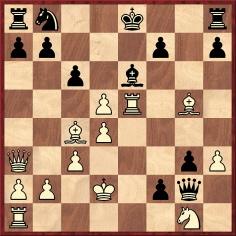
22...f1(N)+ 23 Kd3 Kd7 24 dxe6+ Kc7 25 Qe7+ Kb6 26 Qd8+ Rxd8 27 Bxd8 mate.
See, for instance, game 30 in One Hundred Chess Gems by P. Wenman (London, 1939), where it was described as ‘one of the best games ever played at [sic] the Rice Gambit’.
Below is the title page of the only Wenman book in our collection inscribed by him:
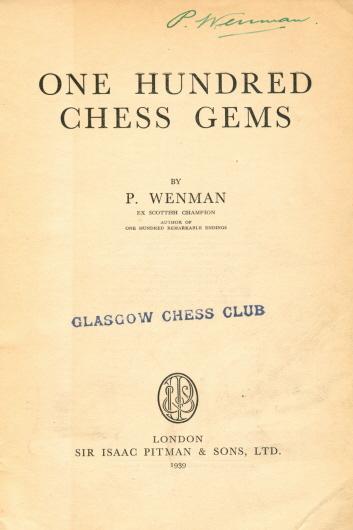
(6923)
From Michael Clapham (Ipswich, England):
‘On pages 479-482 of the December 1951 issue of the Chess Students Quarterly E.G.R. Cordingley wrote an article, “Book Reviewing: An analysis: Quality – Originality – Plagiarism – Ostracism”:’
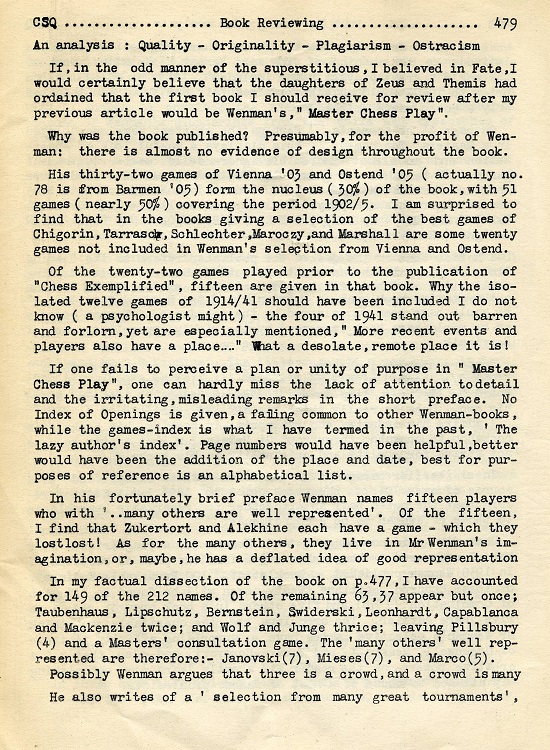
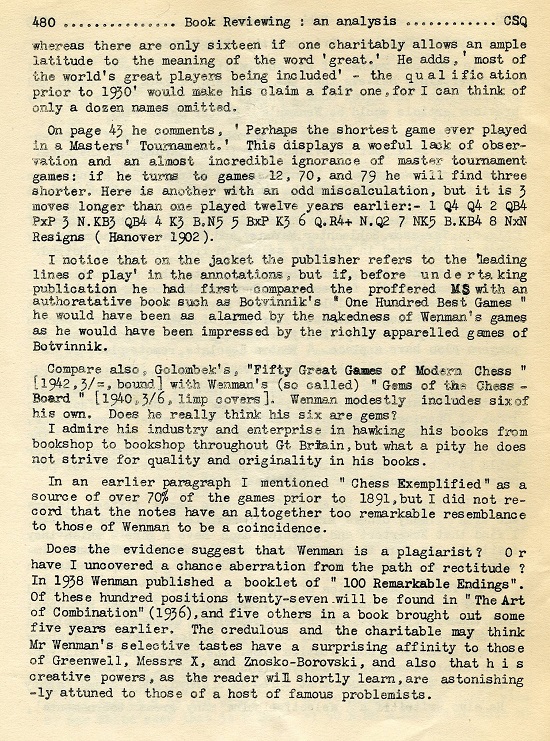
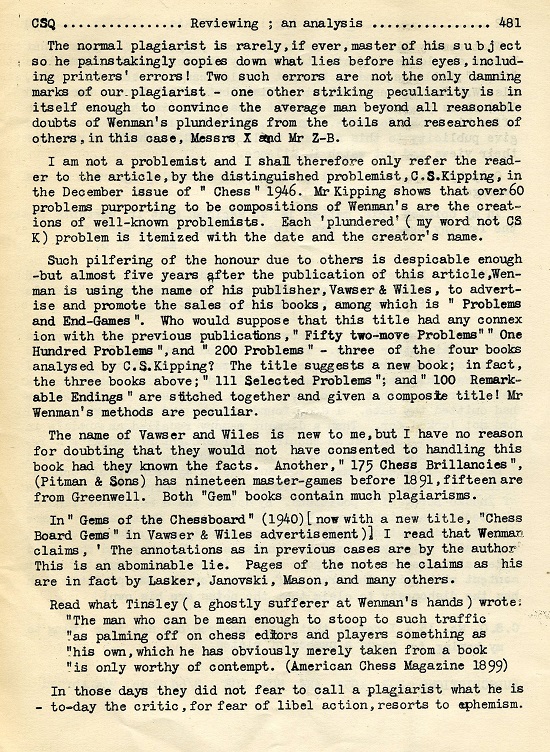
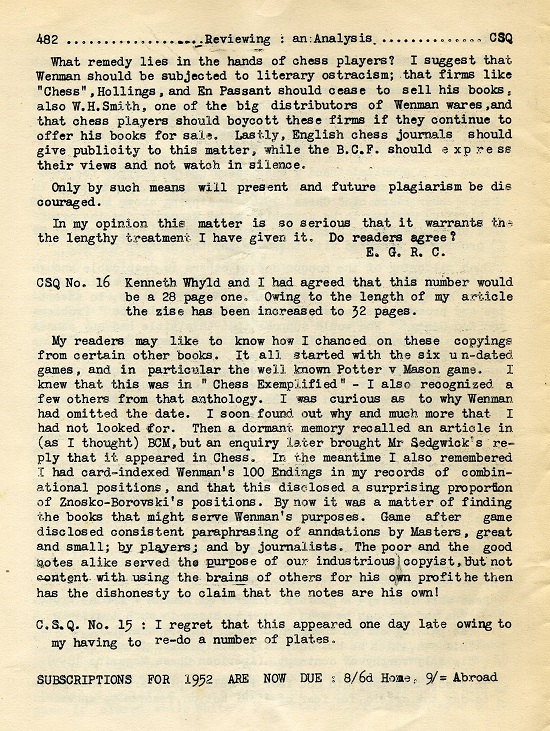
(9686)
Michael Clapham provided an excellent overview of Wenman’s output on his Chess Book Chats website. The Chess Scotland website has a page about Wenman by Alan McGowan.
Addition on 12 March 2024:
As an illustration of how Wenman misappropriated someone else’s sound composition and took credit for a modified, unsound version, Geoff Chandler (Edinburgh) has examined Kipping’s reference above, regarding Problems and Puzzles, to ‘50: Havel, 1920, one file right’. This means that in problem 50 (on page 31) the position which Wenman attributed to himself was an adaptation of a problem by Havel published in 1920 and that to revert to the original, all units in Wenman’s version must be moved one file to the right:
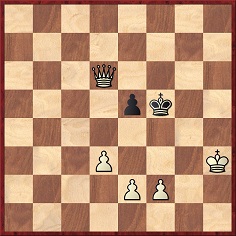
Havel: mate in three
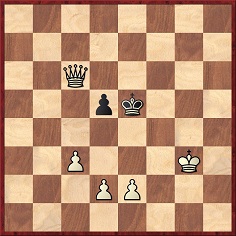
Wenman: mate in three (cooked)
Mr Chandler comments that whereas the Havel problem has only one solution (1 f4), in the Wenman version there is not only the 1 e4 solution which he gave but also 1 d4+:
‘The difference is that in Wenman’s diagram the white queen can reach h6, i.e. 1 d4+ Kf5 2 Qh6 Ke4 3 Qe6 mate or 3 Qf4 mate, but in the original this variation is not available.’
Michael McDowell (Westcliff-on-Sea, England) informs us that from among the standard databases, WinChloe is the only one that includes the Wenman position, with the cook noted.
We add the original appearance of Havel’s composition on page 12 of the Hampshire Telegraph and Post, 2 January 1920:

See too Copying.
To the Archives
for other feature articles.
Copyright Edward Winter. All rights reserved.